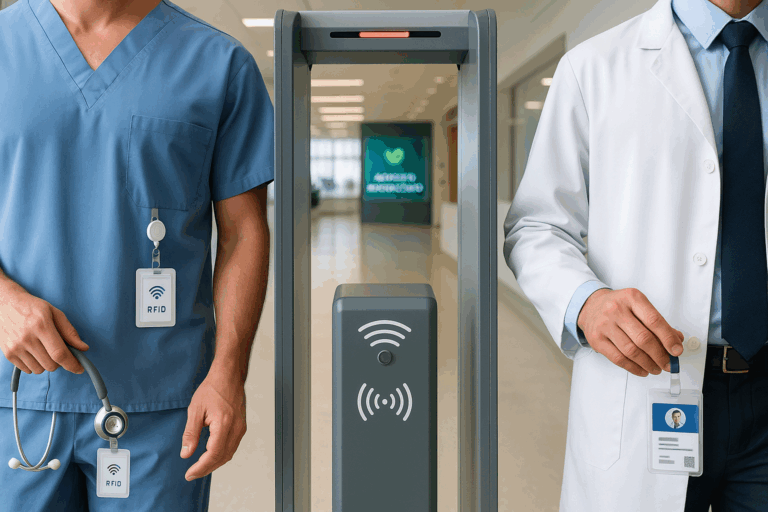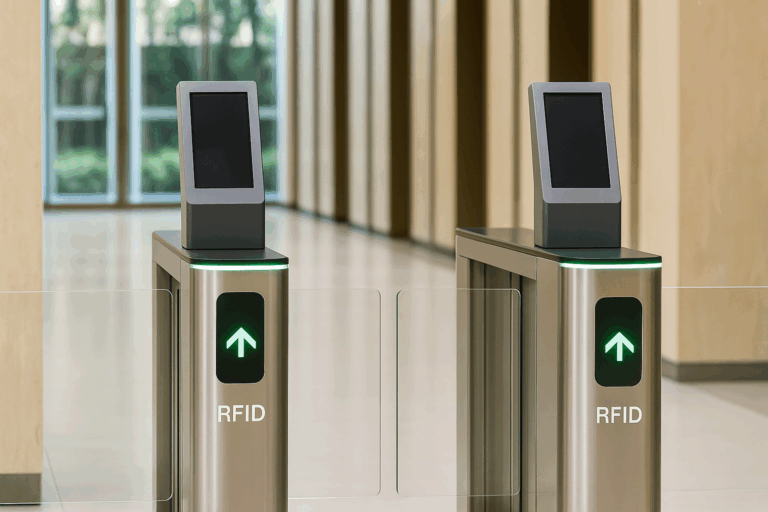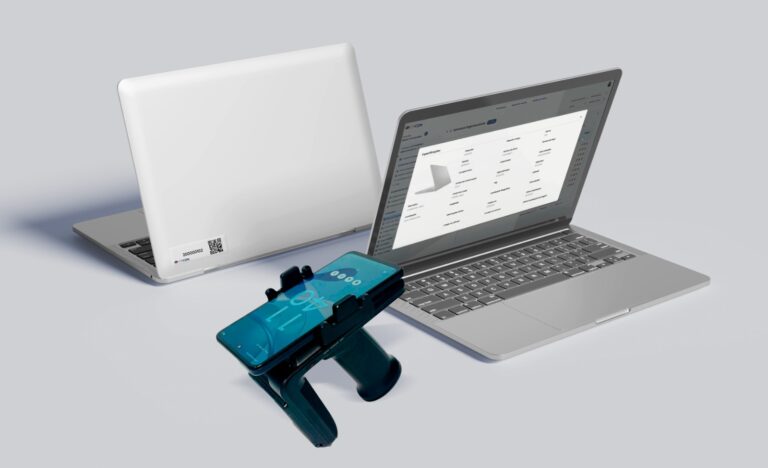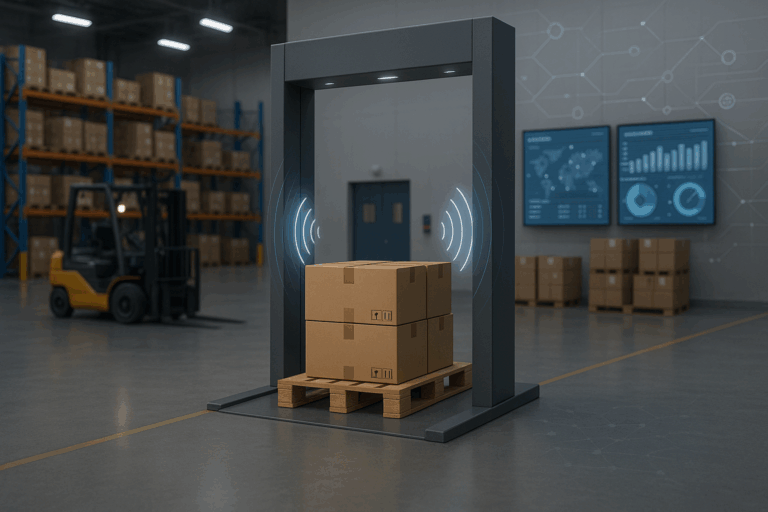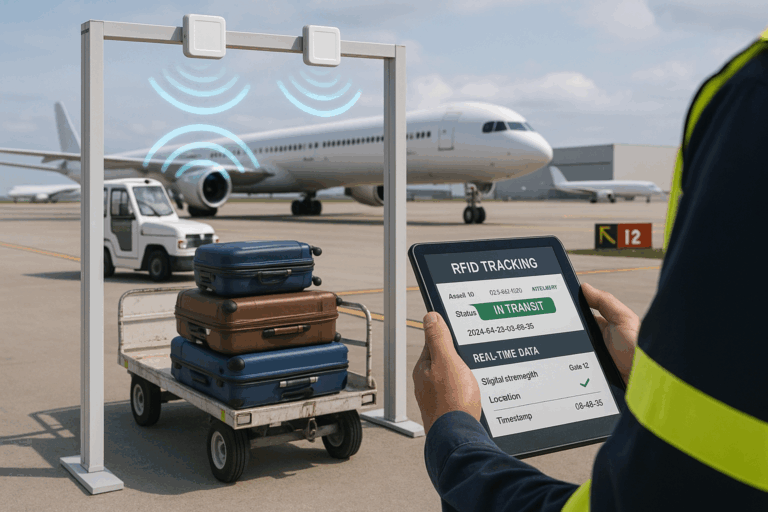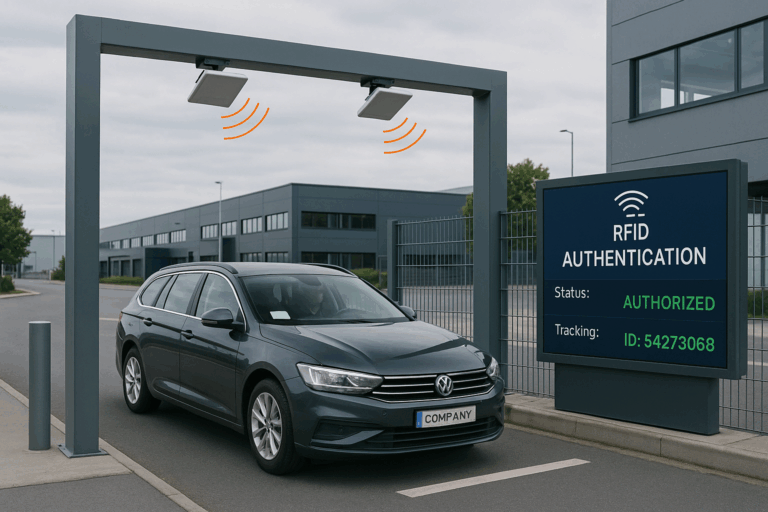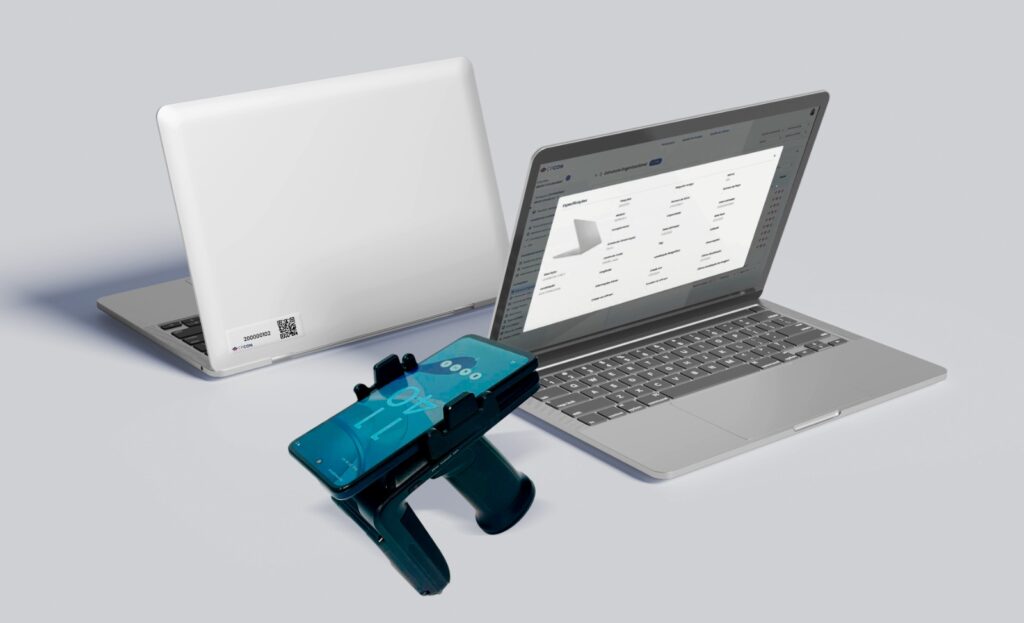Table of Contents
ToggleHospitals and clinics across the U.S. are adopting RFID portals to reduce losses, streamline inventory management, and ensure full visibility over medical assets
What is an RFID portal in healthcare? An RFID portal is a fixed, automated system that tracks hospital assets, equipment, and inventory in real time — as they move in and out of rooms, labs, and storage areas. Unlike handheld scanners, RFID portals work passively: every tagged item is automatically recorded when it passes through. This eliminates manual counting, reduces errors, and helps hospitals maintain full control over critical supplies.
In the U.S., healthcare systems are increasingly adopting RFID portals to solve persistent challenges like medication misplacement, device loss, and inefficient audits. According to the American Hospital Association (AHA), hospitals are under growing pressure to improve inventory accuracy and reduce operational waste — especially in areas like medication storage, surgical kits, and mobile equipment.
Recent data from Research and Markets confirms this shift. The U.S. healthcare RFID market is expected to contribute significantly to the global growth, reaching $15.7 billion by 2030, driven by innovations like smart cabinets, real-time asset tracking, and paperless inventory systems. This movement isn’t just about technology — it’s about giving healthcare teams more time, more visibility, and more power to care for patients.
In this article, you’ll learn:
- How RFID portals work in hospitals
- Why U.S. medical centers are investing in them
- Practical applications in medication, equipment, and patient tracking
- What the market data reveals about adoption and ROI
- And how CPCON offers scalable RFID portal solutions designed for the healthcare sector

What Is an RFID Portal and How It Works in U.S. Healthcare
An RFID portal is a fixed scanning system that automatically detects and records the movement of items equipped with RFID tags. Unlike handheld readers, which require manual scanning one by one, RFID portals operate continuously and hands-free — making them ideal for high-traffic zones in hospitals like supply rooms, ORs, ICUs, and sterilization areas.
These portals typically consist of:
- RFID antennas and readers mounted at doorways or transition points
- Middleware software that filters, stores, and sends the captured data to hospital systems (like ERP or inventory modules)
- Passive or active RFID tags applied to assets, medical supplies, or containers
Real-Life Example in the U.S. Hospital Setting:
Imagine a mobile ultrasound machine leaving a diagnostic room. As it passes through a hallway equipped with an RFID portal, the system logs the exact time, location, and movement — without any human interaction. This data is instantly shared with the hospital’s inventory software, updating its status in real time. If the device enters a restricted area or hasn’t been returned within a defined period, alerts can be triggered automatically.
Why It Matters:
In U.S. healthcare systems where compliance, traceability, and cost efficiency are top priorities, RFID portals are not just a tech upgrade — they’re a control mechanism. They allow administrators to:
- Track high-value medical equipment
- Monitor the movement of pharmaceuticals or surgical kits
- Reduce the time spent on manual inventory
- Prevent theft, loss, and misplacement
📌 According to the American Hospital Association, improving medication and equipment visibility is one of the top priorities in digital transformation. RFID portals directly address that by automating what used to be a manual, error-prone, and labor-intensive process.
Why U.S. Hospitals Are Turning to RFID Portals
The U.S. healthcare system is under constant pressure to improve operational efficiency while maintaining patient safety, regulatory compliance, and cost control. But many hospitals still rely on outdated or manual processes to manage their inventories, equipment, and medication supplies — resulting in waste, delays, and avoidable risks.
Key Challenges Driving RFID Adoption:
- Medication misplacement: A single missing vial or incorrect dosage can trigger patient safety concerns and regulatory penalties.
- Asset mismanagement: High-value medical devices (like infusion pumps or defibrillators) are often moved without proper tracking, leading to delays in care or increased replacement costs.
- Manual inventory inefficiency: Nurses and staff spend hours each week conducting manual counts, diverting time away from direct patient care.
- Audit and compliance gaps: Without real-time data, healthcare providers struggle to meet audit requirements from bodies like The Joint Commission or the FDA.
What the AHA Says:
A 2025 report from the American Hospital Association’s Center for Health Innovation highlights RFID technology — including portals and smart cabinets — as one of the most promising tools for medication inventory management. These solutions are gaining traction for their ability to automatically track usage, flag expirations, and support full chain-of-custody documentation.
The RFID Portal Advantage:
Unlike temporary fixes or point solutions, RFID portals create a permanent infrastructure for control. Once installed, they require minimal intervention and offer continuous, automated visibility.
Hospitals using RFID portals report:
- Fewer missing assets
- Faster inventory reconciliation
- Improved regulatory readiness
- Stronger loss prevention systems
In short, RFID portals help U.S. hospitals shift from reactive inventory models to proactive, data-driven control — a crucial step in building smarter, more resilient healthcare operations.
High-Impact Use Cases in U.S. Medical Centers
RFID portals are not just an IT upgrade — they’re a frontline tool in some of the most critical workflows in modern hospitals. From medication security to surgical preparation, RFID portals bring visibility, automation, and control to high-risk, high-value processes.
Here are the top use cases transforming hospital operations across the U.S.:
Medication Tracking Through Smart Cabinets
In pharmacies and storage rooms, RFID portals and smart cabinets work together to manage drug inventory in real time. Each RFID-tagged medication is automatically logged when it enters or exits a cabinet or crosses a portal. This allows hospitals to:
- Monitor expiration dates
- Prevent diversion or theft
- Ensure stock availability for critical care
This is particularly effective for controlled substances, where federal and state regulations require precise tracking.
Equipment and Device Traceability
Hospital equipment is mobile by nature — ventilators, ECG machines, portable monitors. But without tracking, these devices are often misplaced or delayed during emergencies. RFID portals log every movement, enabling:
- Fast location of equipment
- Maintenance schedule monitoring
- Accurate asset utilization reports
This visibility reduces unnecessary purchases and supports preventive maintenance programs.

Kits and Procedure-Specific Inventory
RFID-tagged surgical kits or diagnostic trays can be automatically verified before entering an OR or a procedure room. This eliminates manual checklist errors and ensures all necessary components are present, sterile, and within expiry.
Hospitals using this model report:
- Fewer canceled procedures due to missing items
- Improved infection control
- Reduced inventory waste
Real-Time Location Systems (RTLS)
Some RFID portals are part of broader RTLS networks. In this setup, hospitals track not just items — but people. Staff, patients, and even visitors wear RFID-enabled badges or wristbands that allow for:
- Patient flow optimization
- Enhanced safety in restricted zones
- Faster response in emergency situations (e.g., code blue)
This level of control is becoming standard in large U.S. academic hospitals and high-volume trauma centers.
RFID in U.S. Healthcare: A Growing Market
RFID technology is no longer an emerging trend — it’s a strategic investment. And the U.S. is leading the charge.
According to the 2025 Research and Markets report, the global RFID in healthcare market is projected to reach $15.7 billion by 2030, with North America as the dominant region. The report credits this growth to innovations such as smart labeling, RFID-enabled cabinets, and fully automated inventory systems — all of which are increasingly adopted by U.S. hospitals and healthcare networks.
What’s Fueling This Market Surge?
- Operational efficiency: RFID portals reduce manual labor and free up staff for patient-facing tasks
- Regulatory pressure: Healthcare providers must comply with standards from HIPAA, The Joint Commission, and the FDA, all of which benefit from precise, real-time documentation
- Cost control: RFID reduces asset loss, overstocking, and expired inventory — all of which directly impact hospital budgets
- Digitization efforts: As healthcare shifts toward paperless systems and integrated platforms, RFID portals act as a bridge between physical assets and digital management
U.S. Leads in Adoption and Innovation
Hospitals across the U.S. — from large academic medical centers to regional clinics — are increasingly viewing RFID not just as a tracking tool, but as an infrastructure for smarter decision-making.
This is especially relevant in areas like:
- Surgical services (where downtime is expensive)
- Emergency care (where equipment must be instantly available)
- Outpatient and specialty clinics (where medication compliance and patient flow are key)
In short, RFID portals are becoming foundational to a more resilient, responsive, and cost-efficient U.S. healthcare system.
Main Benefits for U.S. Healthcare Providers
Implementing RFID portals in hospital environments doesn’t just optimize logistics — it delivers measurable results across compliance, safety, and financial performance. For U.S. healthcare providers under increasing pressure to “do more with less,” the benefits are clear and immediate.
1. Real-Time Inventory Accuracy
No more guesswork. Every item that enters or leaves a supply room, pharmacy, or surgical suite is automatically logged. This enables:
- Live inventory dashboards
- Auto-replenishment triggers
- Fewer stockouts or overstock situations
2. Faster, Easier Regulatory Compliance
Hospitals can generate audit trails instantly, showing when and where each medication or device was used. This supports requirements from:
- The Joint Commission
- FDA (for drug traceability)
- HIPAA (for patient data protection when tied to RTLS)
3. Loss Prevention and Asset Security
RFID portals detect unauthorized movements of tagged items — from medical tools to controlled substances. This reduces:
- Equipment theft or misplacement
- Diversion of high-risk medications
- Costs from lost or duplicated assets
4. Cost Reduction and Operational Efficiency
Manual inventory checks are labor-intensive. RFID automation frees up nurses, techs, and logistics teams to focus on value-added tasks. Hospitals report:
- Lower labor hours for inventory
- More informed purchasing decisions
- Better equipment utilization rates
5. Data-Driven Decision Making
With every movement logged and time-stamped, healthcare leaders gain insights into usage patterns, equipment downtime, and inventory cycles — enabling:
- Predictive maintenance
- Forecasting of critical stock
- Optimization of storage layout and workflows

Why Healthcare Leaders Choose CPCON RFID Portals
At CPCON, we understand that managing hospital assets isn’t just about tracking — it’s about control, compliance, and clarity. That’s why our RFID portal solutions are built for the real-world needs of U.S. healthcare systems: scalable, secure, and fully aligned with your operational goals.
Tailored for Complex Healthcare Environments
Our RFID portals are designed to seamlessly integrate with:
- Hospital ERP and inventory management systems
- RTLS platforms and medication tracking solutions
- Custom workflows for high-traffic or restricted areas
Whether it’s a single department or a multi-site network, we adapt our infrastructure to fit your operational landscape.
From Implementation to Optimization
We don’t just install — we partner. Our expert teams provide:
- Strategic consulting to define RFID goals and KPIs
- On-site deployment and calibration for maximum read accuracy
- Training and support to ensure adoption by staff and management
Precision, Security, and Compliance
With over 25 years of experience in asset control and enterprise risk, CPCON offers:
- Secure RFID data protocols
- Compliance-ready documentation
- Audit support and lifecycle reporting
You’re not just getting hardware. You’re gaining a strategic infrastructure for control — built on technology, expertise, and trust.
A Global Partner With Local Insight
From our offices in the U.S., Brazil, and Mexico, CPCON supports clients across the Americas. Our RFID portal solutions are used by healthcare leaders who demand accuracy, visibility, and long-term ROI — and we deliver on all fronts.
Ready to bring real-time control to your healthcare facility?
Talk to our experts and explore a customized RFID portal solution today!
RFID Portal as a Strategic Pillar in U.S. Healthcare
The RFID portal is no longer a luxury — it’s a necessity for hospitals aiming to streamline operations, reduce risk, and enhance patient safety. With rising regulatory demands and limited resources, U.S. healthcare providers are turning to this technology for real-time control over their assets, inventory, and compliance.
CPCON is ready to support this transformation with RFID portal solutions built specifically for the complexity of medical environments. From medication tracking to mobile equipment monitoring, we deliver visibility, accuracy, and confidence — so you can focus on what matters most: care delivery.
Learn more:
- RFID Portal for Logistics: The Smart Way to Control Your Supply Chain
- RFID Portal for Airports: Intelligence and operational control for your management
- RFID & F1: Accelerating innovation with smart tracking
FAQ
What is the difference between an RFID portal and a handheld RFID reader in hospitals?
An RFID portal is a fixed, automated system that continuously tracks tagged items as they move through doors or corridors — no manual scanning required. Handheld readers are portable but depend on user interaction and are less efficient for high-volume environments like hospitals.
How does an RFID portal improve inventory control in healthcare?
RFID portals offer real-time visibility into inventory levels, movement, and usage. This eliminates manual counting, prevents overstocking, and ensures the right supplies are available when needed — especially in emergency or surgical units.
Are RFID portals compliant with U.S. healthcare regulations?
Yes. RFID portals can support compliance with regulations from The Joint Commission, FDA, and HIPAA by providing traceable, time-stamped records of asset movement and medication handling. They also help hospitals prepare for audits with minimal manual reporting.
Can RFID portals track both equipment and medication?
Absolutely. RFID portals can be used for a wide range of healthcare assets — from infusion pumps and monitors to medication vials and surgical kits. Combined with RFID tags and smart cabinets, they deliver full control across departments.
How much does it cost to implement an RFID portal in a hospital?
Costs vary based on hospital size, number of portals, and integration needs. However, most hospitals see strong ROI through reduced losses, fewer labor hours, and improved asset utilization. CPCON offers customized proposals based on your facility’s goals and scale.
Get to Know CPCON Group: A global expert in asset management and inventory solutions
CPCON Group is a global leader in asset management, fixed asset control, and RFID technology. With over 25 years of experience, we have supported major companies such as Nestlé, Pfizer, Scania, BASF, Coca-Cola Andina, Vale, Vivo, Petrobras, and Caixa in high-complexity projects.
Curious about our global footprint? We are present in:
- North America: Toronto, New York, Miami, Minneapolis, Seattle, Dallas
- Latin America: São Paulo, Buenos Aires, Lima, Bogotá, Mexico City
- Europe: Lisbon, Porto, London, Birmingham, Milan, Rome, Turin, Madrid, Bilbao
- Middle East: Dubai, Saudi Arabi
- Caribbean: Tortola, Grand Cayman
Follow our LinkedIn Showcase Page and stay updated with strategic content on asset control, inventory management, and RFID innovation across industries.
Hospitals and clinics across the United States are adopting RFID portals to transform how they manage medical assets and inventory. These fixed systems automate the tracking of equipment, medication, and surgical kits, eliminating manual errors and improving operational efficiency. This article explains how RFID portals work, how they differ from handheld readers, and the key benefits for U.S. healthcare — including real-time visibility, regulatory compliance, reduced losses, and time savings. Citing insights from the American Hospital Association and Research and Markets, we highlight why the U.S. is leading adoption, with the market projected to surpass $15.7 billion by 2030. CPCON stands out by offering scalable, integrated, and secure RFID portal solutions tailored for healthcare, backed by deep consulting expertise and a strong presence in the U.S. market.

